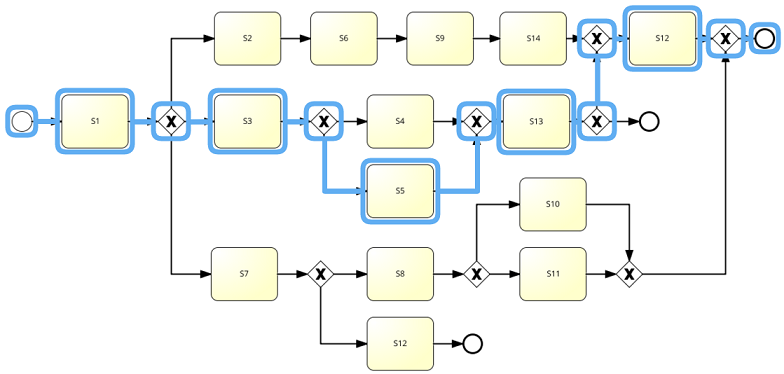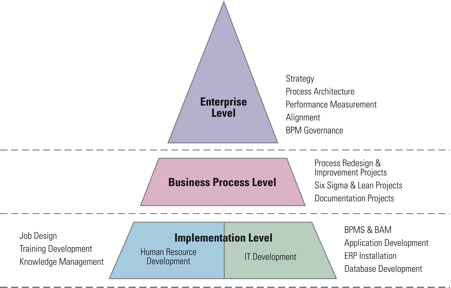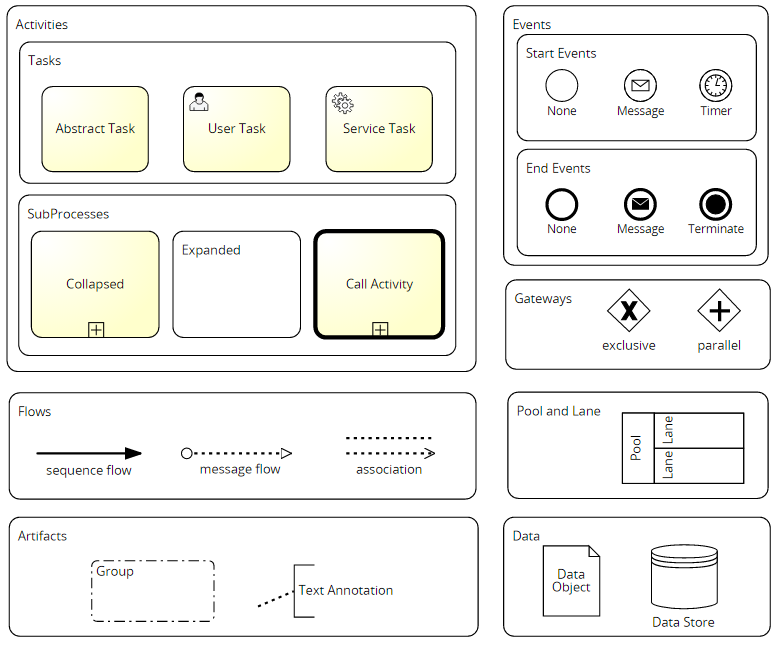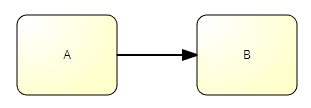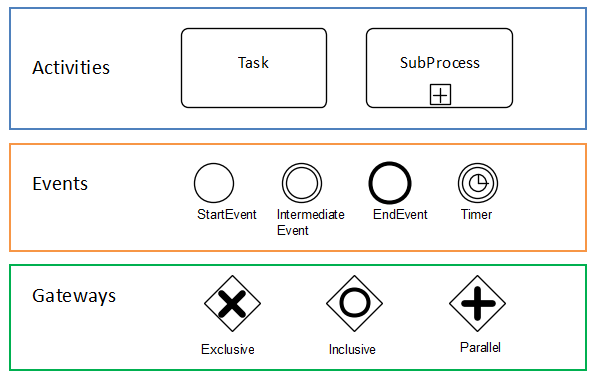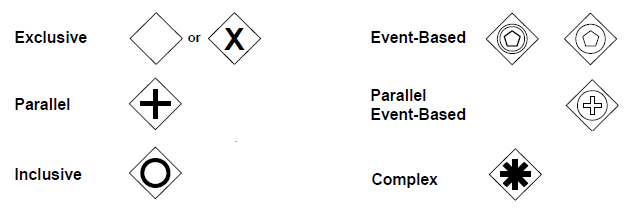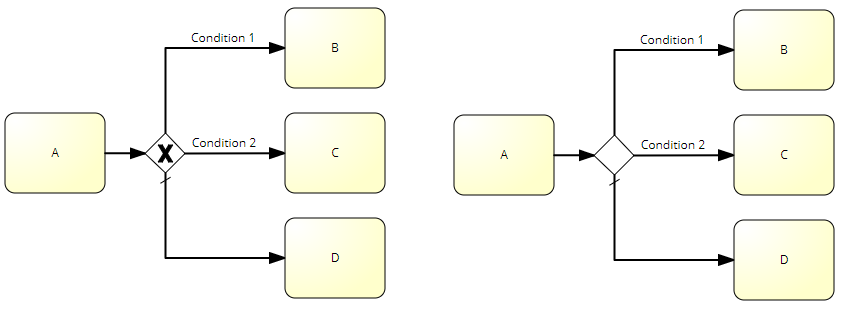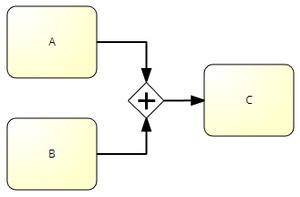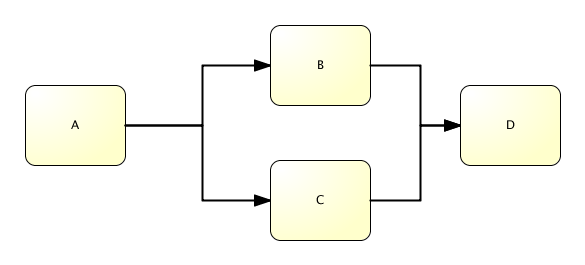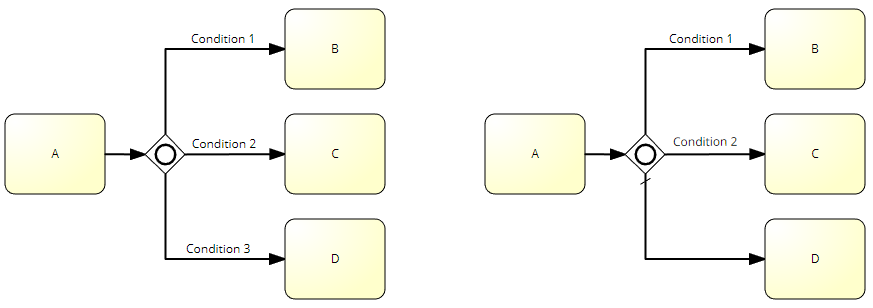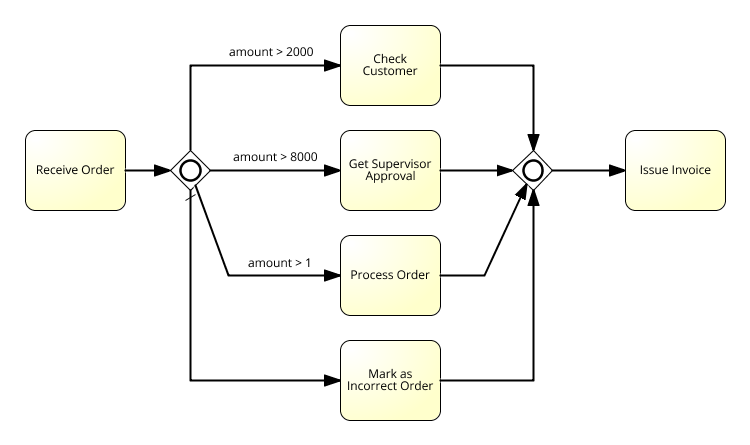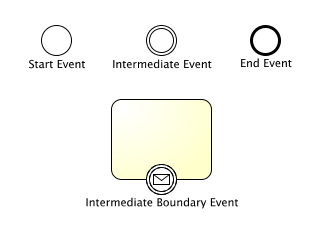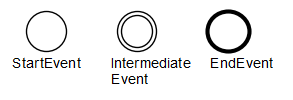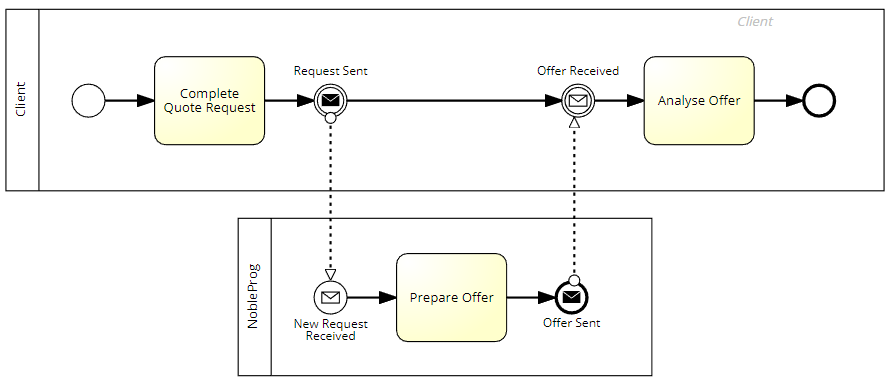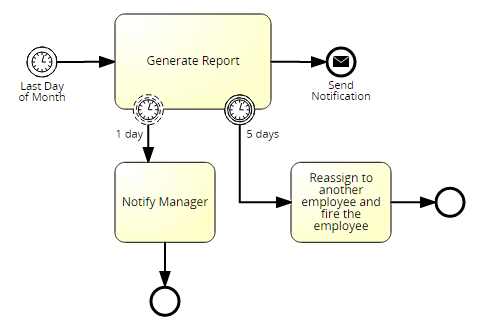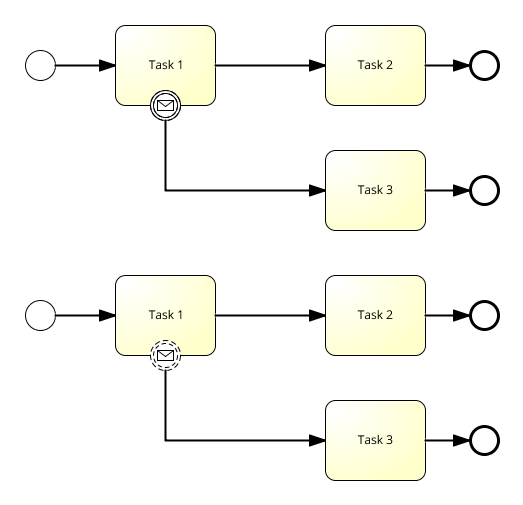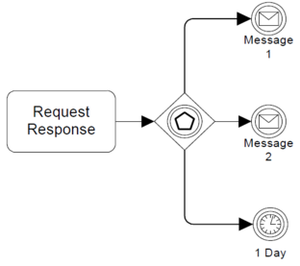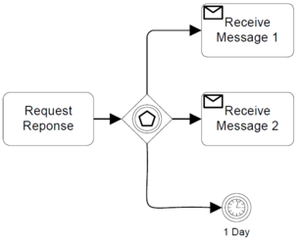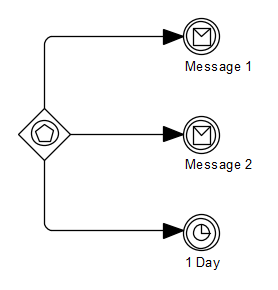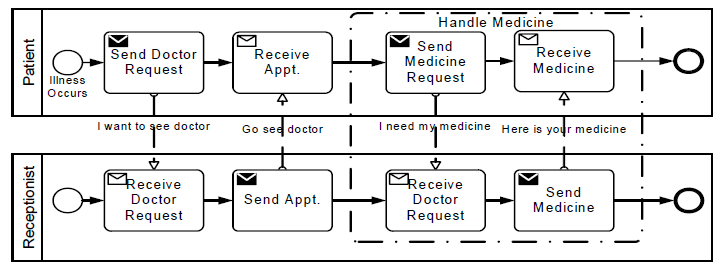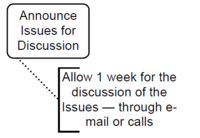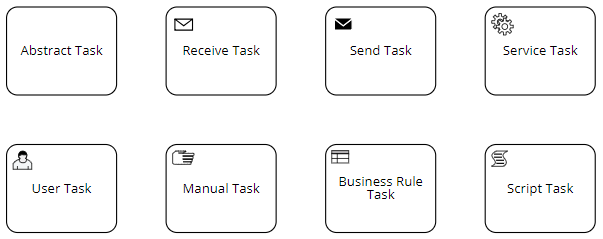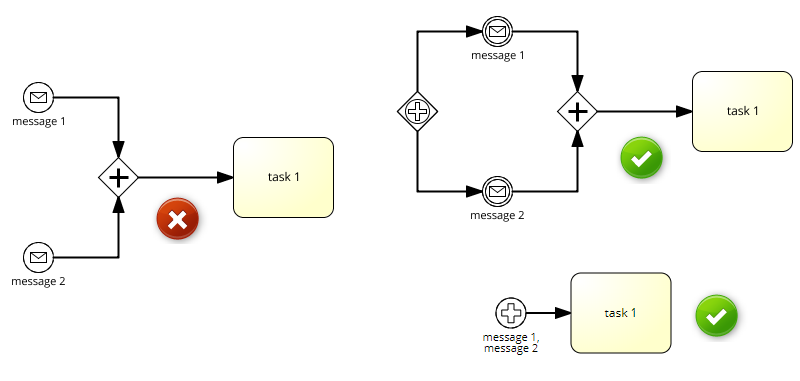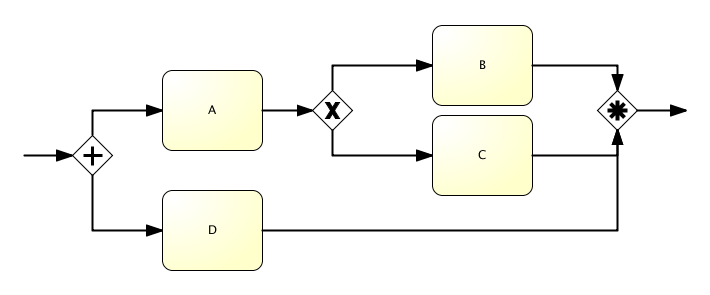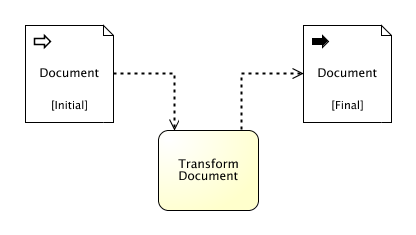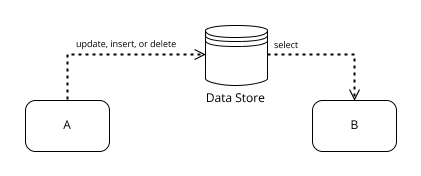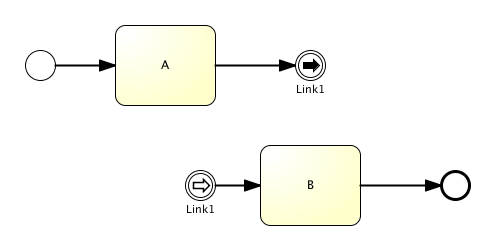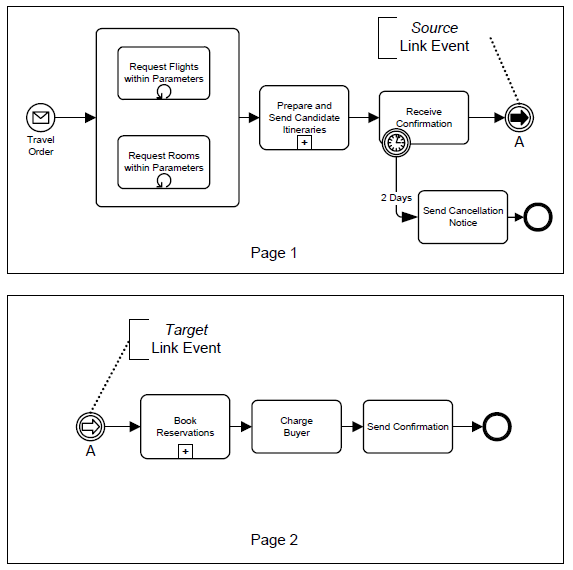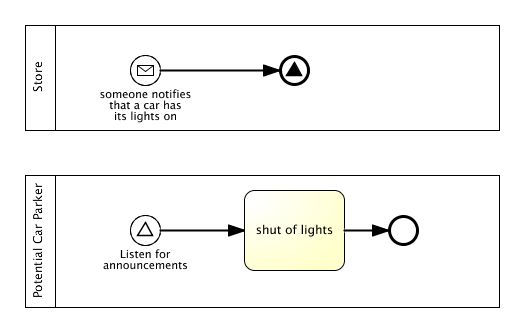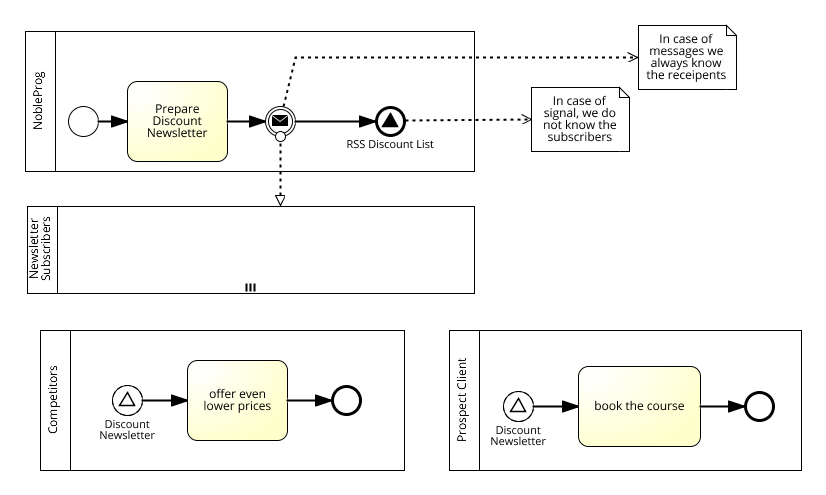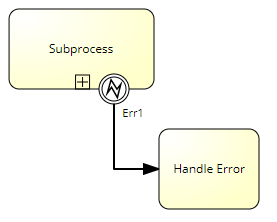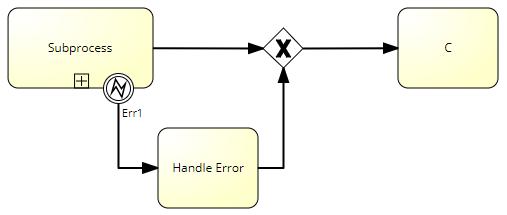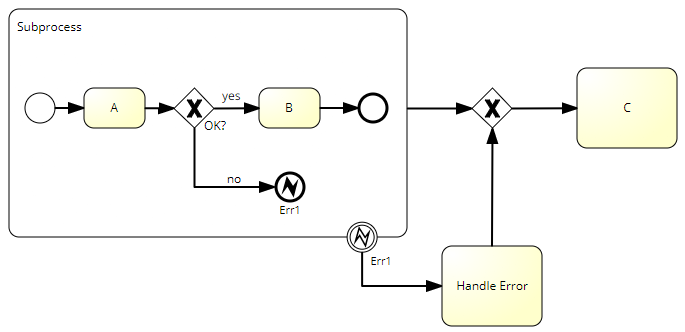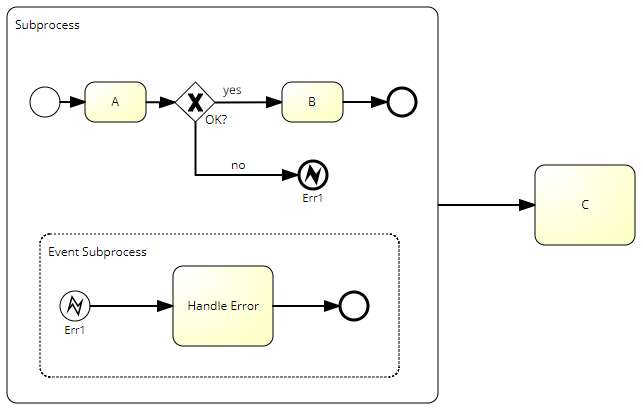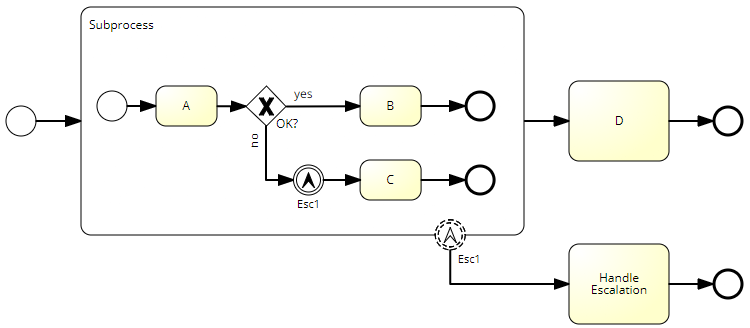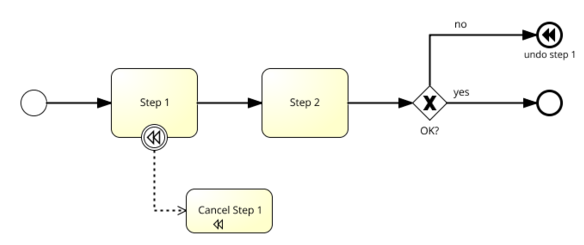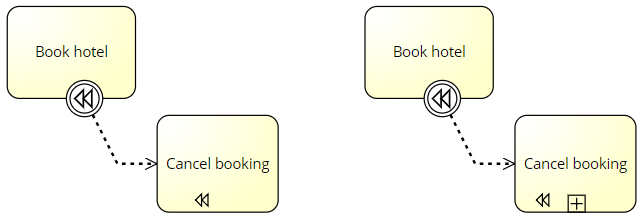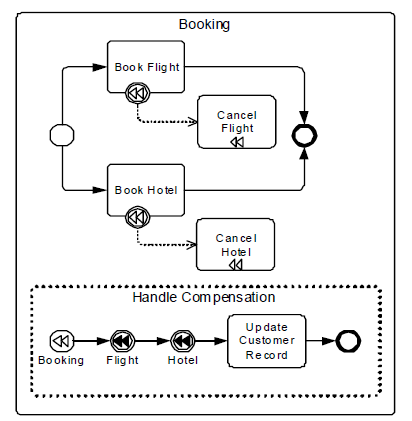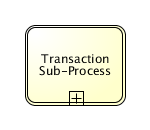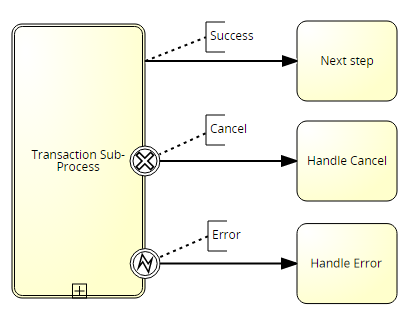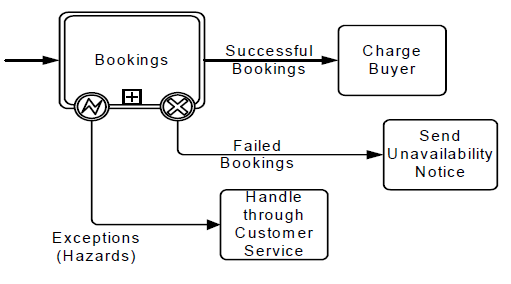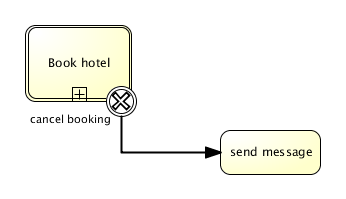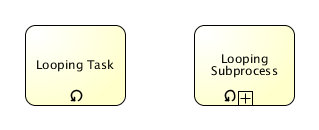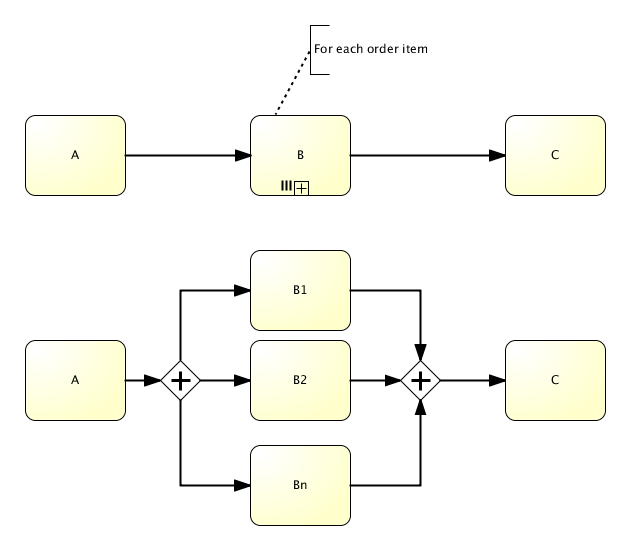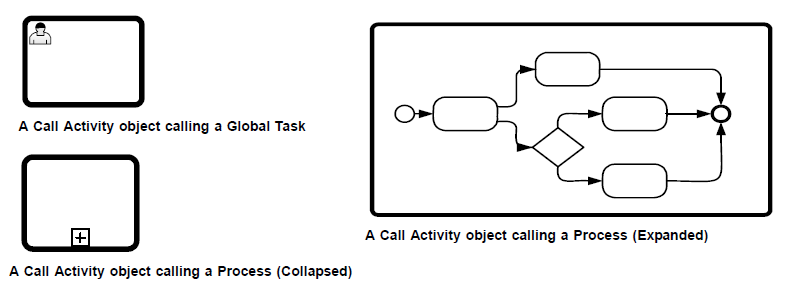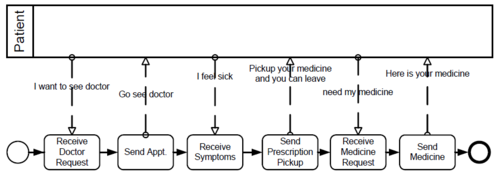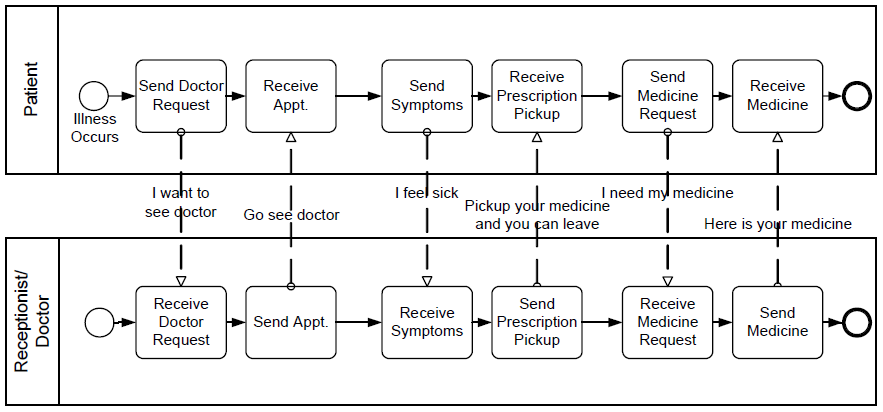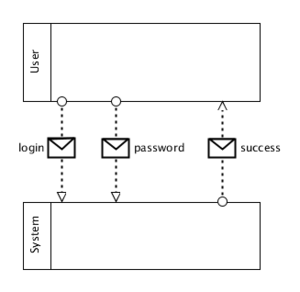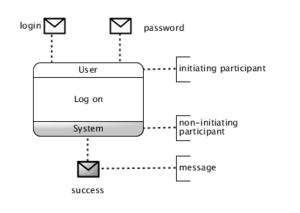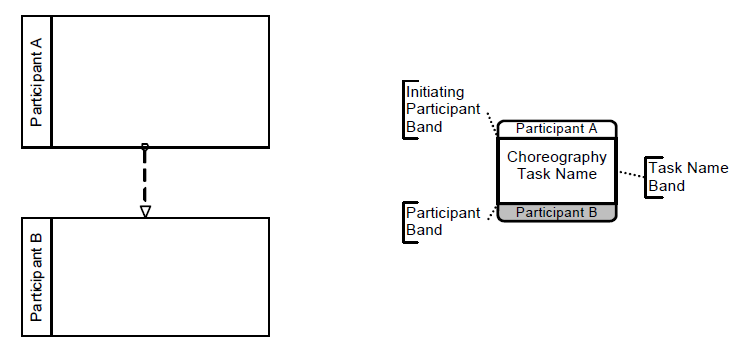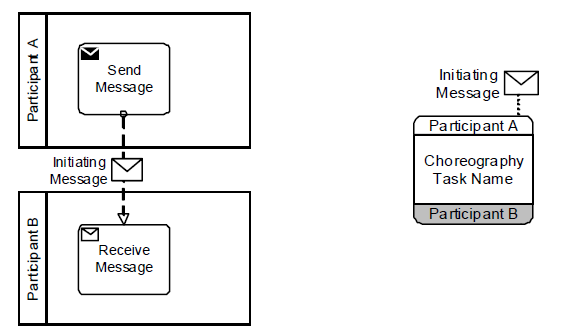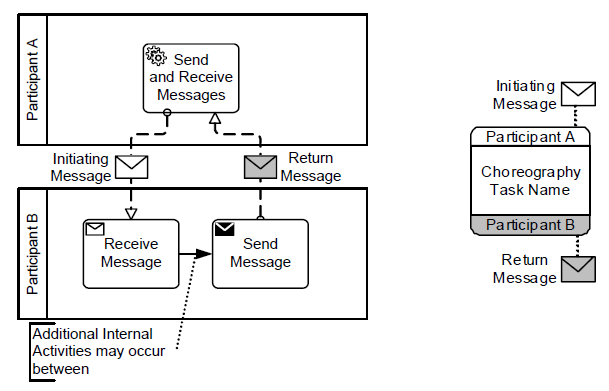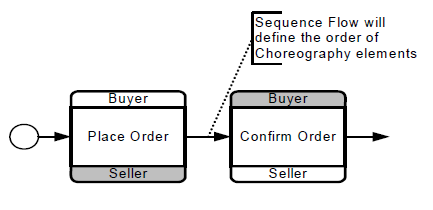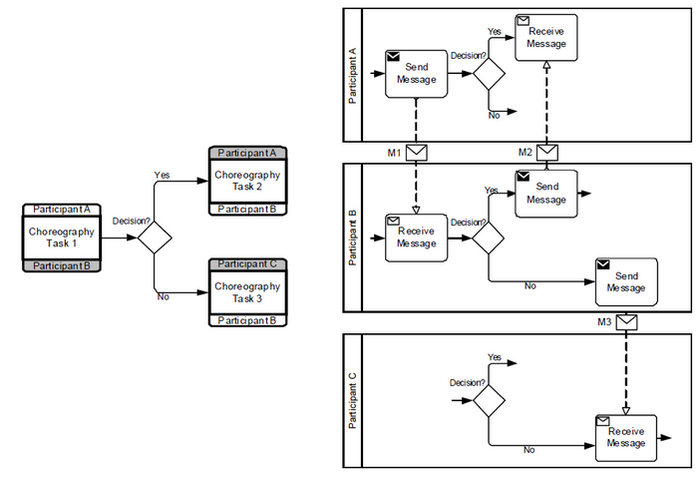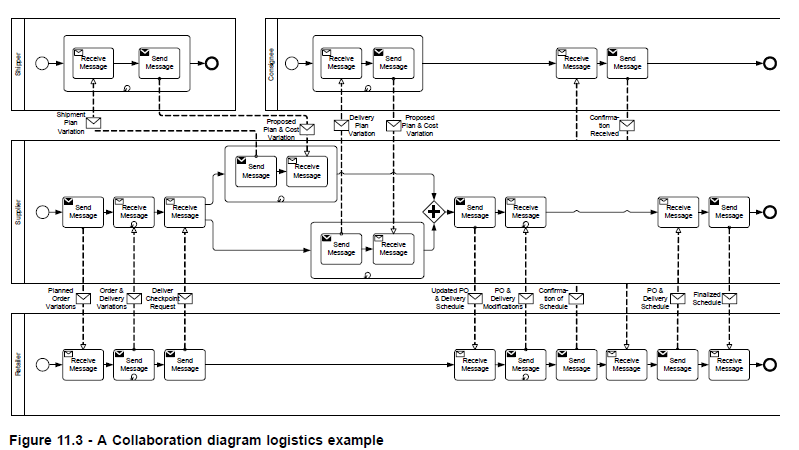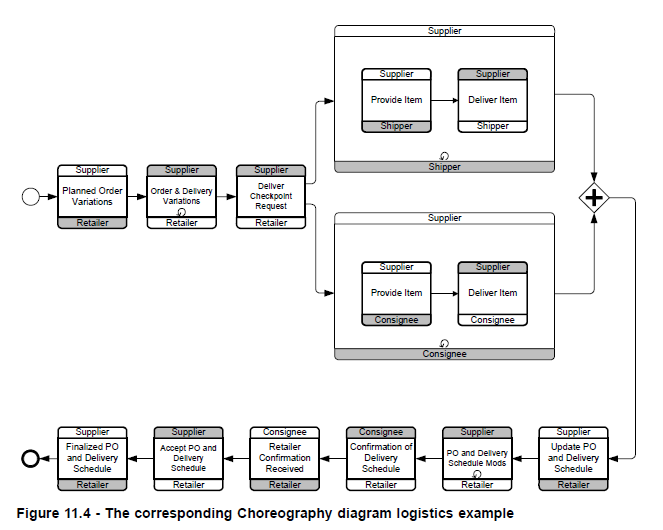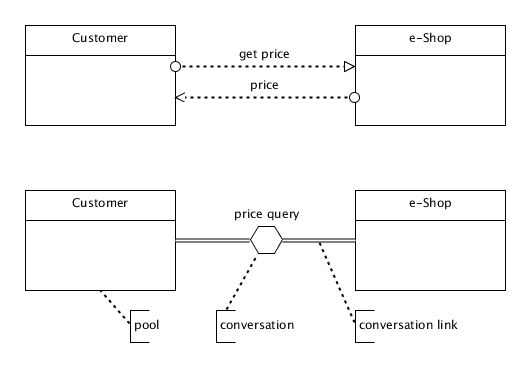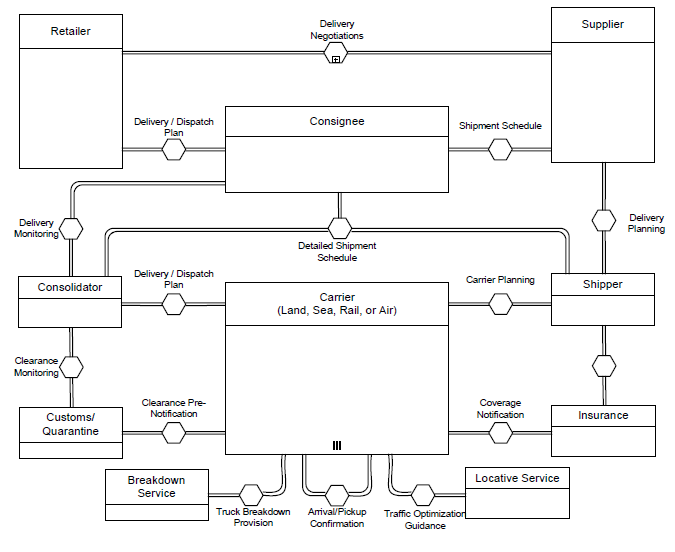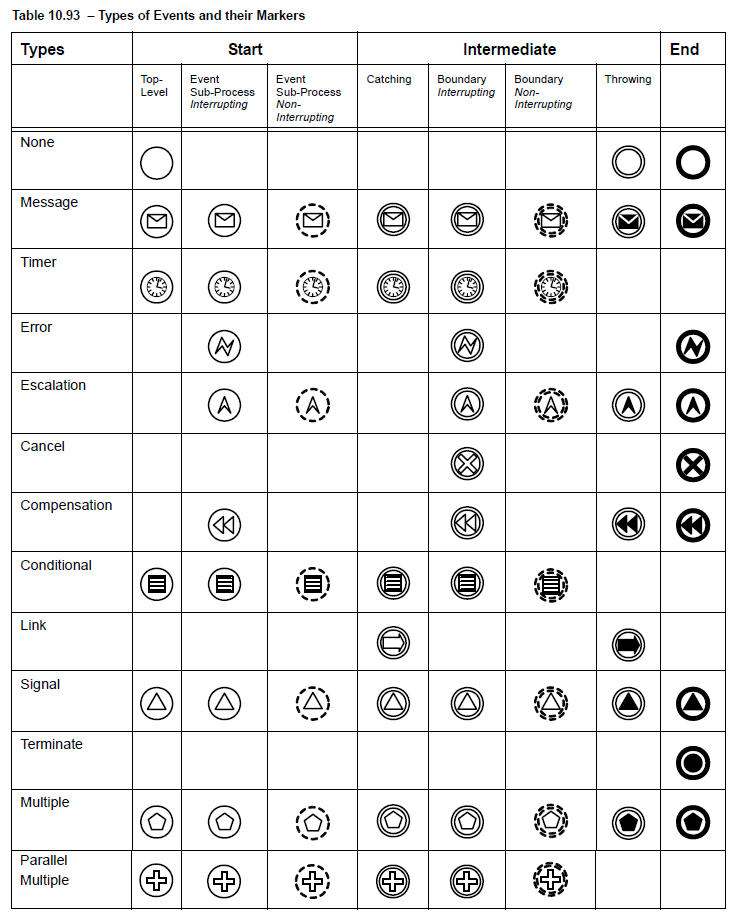BPMN 2.0 for Business Analysts
Copyright ⌘
Most of our training material is based on the BPMN 2.0 Specification http://www.omg.org/spec/BPMN/2.0/
Business Process⌘
BPMN 2.0 Spec:
A Process describes a sequence or flow of Activities in an organization with the objective of carrying out work.
Howard Smith, Peter Fingar, Business Process Management – The Third Wave, Meghan Kiffer, 2006:
Business Process is the complete and dynamically coordinated set of collaborative and transactional activities that deliver value to customers.
Process Logic⌘
by Bruce Silver
- Process Logic (Process Model) is a complete map of all the paths from the triggering event to any defined end state.
- Process Model is more than documentation of one instance of the process.
- Process logic is usually hidden.
BPMN⌘
- Business Process Model and Notation (BPMN)
- OMG standard
- similar to flowchart diagram, but
- formal (specification - http://www.omg.org/spec/BPMN/2.0/)
- event based
- with message flows
BPMN benefits⌘
- standard notation maintained by OMG
- not vendor specific
- free
Demonstration⌘
- Simple process
Levels of Process Modelling⌘
ISO 9000:2015 3.4.1 process
set of interrelated or interacting activities that use inputs to deliver an intended result
ISO 9000:2015 3.4.5 procedure
specified way to carry out an activity or a process (3.4.1)
Levels of BPMN Process Modelling⌘
by Bruce Silver - Three Levels of Process Modeling with BPMN, BPMS Watch, April 2008
- Descriptive modeling
- Abstract, high-level, simple to communicate across the organization
- occasionally ignoring BPMN’s diagram validation rules
- Requires understanding of fundamental concepts such as pools and lanes, tasks and subprocesses and sequence flow, not the complexities of BPMN's various flow control and event patterns
- Analytical modeling
- More details, showing all the steps, including the exception paths required to analyze process performance using simulation or to create details requirements for an IT implementation. Requires understanding of BPMN's various decisions and merge patterns, event and exception handling patterns. Hierarchical representation of the end to end business process
- Executable modeling
- BPMN is a part of the executable process implementation. Imposes many validation constraints.
- Modeling at this level is somewhat vendor tool-dependent.
Descriptive modeling⌘
BPMN Activity⌘
An Activity
- is work that is performed within a Business Process
- can be atomic or non-atomic (compound)
- represent points in a Process flow where work is performed
- is executable element of a BPMN process
Types of Activities⌘
- Task
- an atomic Activity within a Process flow
- is used when the work in the Process cannot be broken down to a finer level of detail
- Sub-Process
- compound activity
- Event Sub-Process
- Transaction
- Ad-Hoc
- compound activity
- Call Activity
- allows the inclusion of re-usable Tasks and Processes in the diagram
Types of Sub-Processes⌘
Sequence Flow⌘
A Sequence Flow is used to show the order that Activities will be performed in a Process.
Token ⌘
- Token traverses the Sequence Flows and passes through the elements in the Process
- A token is a theoretical concept that is used as an aid to define the behavior of a Process that is being performed
- The behavior of Process elements can be defined by describing how they interact with a token as it “traverses” the structure of the Process.
- A token does NOT traverse a Message Flow
Sequence Flow Splitting⌘
- Conditional flow - sequence flow with a condition that is evaluated to determine whether or not the sequence flow will be used
- Default flow - used only if all the other outgoing conditional flows are not true
Basic BPMN Flow Objects⌘
Gateways ⌘
|
Gateways are used to control splitting and merging of sequence flows.
|
Exclusive Gateway ⌘
XOR Gateway
- A diverging Exclusive Gateway (Decision) is used to create alternative paths within a Process flow
- Only one of the paths can be taken, this means the gateway is exclusive
- A Decision can be thought of as a question that is asked at a particular point in the Process
- The question has a defined set of alternative answers
- Each answer is associated with a condition Expression that is associated with a Gateway’s outgoing Sequence Flows
Exclusive Gateway Example⌘
Merging (exclusive)⌘
Parallel Gateway ⌘
AND Gateway
- A Parallel Gateway is used to create or synchronize (combine) parallel flows
- A Parallel Gateway creates parallel paths without checking any conditions; each outgoing Sequence Flow receives a token upon execution of this Gateway
- For incoming flows, the Parallel Gateway will wait for all incoming flows before triggering the flow through its outgoing Sequence Flows
Parallel Gateway Example 1⌘
Parallel Gateway Example 2⌘
Gateway Exercises⌘
- Exercise 1.
- Exercise 2.
- Demonstration - splitting and merging
Inclusive Gateway ⌘
OR Gateway
- A diverging Inclusive Gateway (Inclusive Decision) can be used to create alternative but also parallel paths within a Process flow
- Unlike the Exclusive Gateway, all condition Expressions are evaluated
- The true evaluation of one condition Expression does not exclude the evaluation of other condition Expressions
- All Sequence Flows with a true evaluation will be traversed by a token
- Since each path is considered to be independent, all combinations of the paths MAY be taken, from zero to all
- However, it should be designed so that at least one path is taken.
Inclusive Gateway Example 1⌘
Inclusive Gateway Example 2⌘
Gateway Exercises 2⌘
- Exercise 3.
- Exercise 4.
Events ⌘
An Event is something that “happens” during the course of a Process.
- Events affect the flow of the Process and usually have a cause or an impact. The term “event” is general enough to cover many things in a Process.
- The start of an Activity, the end of an Activity, the change of state of a document, a Message that arrives, etc., all could be considered Events
Events ⌘
- Types of events:
- Start Events - indicate where a particular Process will start
- Intermediate Events - indicate where something happens (an Event) somewhere between the start and end of a Process
- Boundary Intermediate Events - attached to the boundary of an Activity
- End Events - indicate where a Process will end
Events Example⌘
None Events⌘
- None Event does not have a defined trigger or result.
- The Event MUST be displayed without a marker
- None Start Event starts the process and generates new token
- None End Event ends a particular flow and consumes the token
Events Exercises⌘
- Exercise 1.
Pool and Participant⌘
- The pool shape represents a participant.
- A Lane is a sub-partition within within a Pool.
- Lanes are used to organize and categorize Activities.
- The meaning of the Lanes is up to the modeler.
- Lanes are often used for such things as internal roles (e.g., Manager, Associate), systems (e.g., an enterprise application), an internal department (e.g., shipping, finance),
Messages and Message Flows ⌘
- A Message represents the content of a communication between two Participants.
- A Message Flow is used to show the flow of Messages between two Participants that are prepared to send and receive them.
- A Message Flow MUST connect two separate Pools. They connect either to the Pool boundary or to Flow Objects within the Pool boundary. They MUST NOT connect two objects within the same Pool.
Demonstration ⌘
- Pool, Lane, Blackbox
4 Basic Message Events ⌘
Message Events Example⌘
Collaboration Exercises⌘
- Exercise 1.
- Exercise 2.
- Exercise 3.
Timer Events ⌘
- Expresses a time gap in processing or a wait for a period of time.
- Start Timer – start on specific date (Monday at 9am, etc..)
- Intermediate Timer - a specific time-date or a specific cycle (e.g., every Monday at 9am)
- If used in the main flow it acts as a delay mechanism
Timer Example 1⌘
Timer Example 2⌘
Interrupting vs. Non-Interrupting⌘
Boundary Events Exercises⌘
- Exercise 1:
Event-Based Exclusive Gateway⌘
- The Event-Based Gateway represents a branching point in the Process where the alternative paths that follow the Gateway are based on Events that occur
- This is opposed to the evaluation of Expressions using Process data (as with an Exclusive or Inclusive Gateway which are Data Based)
- A specific Event, usually the receipt of a Message, determines the path that will be taken
- Basically, the decision is made by another Participant, based on data that is not visible to Process, thus, requiring the use of the Event-Based Gateway.
Example⌘
- A company is waiting for a response from a customer they will perform one set of Activities if the customer responds “Yes” and another set of Activities if the customer responds “No.”
- The customer’s response determines which path is taken
- The identity of the Message determines which path is taken
- That is, the “Yes” Message and the “No” Message are different Messages
Example⌘
- The receipt of the Message can be modeled with an Intermediate Event with a Message trigger or a Receive Task
- In addition to Messages, other triggers for Intermediate Events can be used, such as Timers
Event-Based Gateway Starts a Process⌘
Event-Based Gateway Exercises⌘
- Exercise 1:
- Exercise 2:
Artifacts ⌘
Artifacts are used to provide additional information about the Process
Group ⌘
- Provides a visual mechanism to group elements of a diagram informally.
- Group can be used for documentation or analysis purposes.
- Groups do not affect the flow of the Process.
Text Annotation ⌘
- Is a mechanism for a modeler to provide additional information for the reader of a BPMN Diagram
- The Text Annotation object can be connected to a specific object on the Diagram with an Association
- Does not affect the flow of the Process
Types of Tasks ⌘
Receive Task ⌘
- Waits for a Message to arrive from an external Participant
- Once the Message has been received, the Task is completed
- Starts the process
- MUST NOT have any incoming Sequence Flow
- Instantiate attribute MUST be set to true
Send Task ⌘
- Sends a Message to an external Participant.
- Once the Message has been sent, the Task is completed.
Asynchronous Communication - tasks⌘
Asynchronous Communication - events⌘
Service Task ⌘
- uses some sort of service, which could be a Web service or an automated application.
Synchronous Communication ⌘
User Task ⌘
- A typical “workflow” Task where a human performer performs the Task with the assistance of a software application
- Examples:
- Phone operator updates customer record
- User changes his password
Manual Task ⌘
- Is expected to be performed without the aid of any business process execution engine or any application
- Example:
- A telephone technician installing a telephone at a customer location
Business Rule Task ⌘
- Provides a mechanism for the Process to provide input to a Business Rules Engine and to get the output of calculations that the Business Rules Engine might provide
Script Task ⌘
- Is executed by a business process engine
- The modeler or implementer defines a script in a language that the engine can interpret
- When the Task is ready to start, the engine will execute the script
- When the script is completed, the Task will also be completed.
Parallel Event-Based Gateway⌘
- All events must occur before a process can start
Complex Gateway⌘
- The Complex Gateway can be used to model complex synchronization behavior
- For example, it could specify that tokens on three out of five incoming Sequence Flows are needed to activate the Gateway.
Data Modeling⌘
- Data modeling is used to describe physical or information items that are created, manipulated, and used during the execution of a Process.
- Data can be modeled using: Data Objects, Data Inputs, Data Outputs, Data Stores, Data Associations, ....
Data Objects⌘
- The primary construct for modeling data within the Process flow.
- Data Associations are used to move data between Data Objects.
- Tokens do not flow along a Data Association.
Data Input, Data Output⌘
- Activities and Processes often need data in order to execute.
- In addition they can produce data during or as a result of execution.
- Data requirements are captured as Data Inputs.
- Data that is produced is captured using Data Outputs.
Data Store⌘
- A DataStore provides a mechanism for Activities to get or update stored information that will persist beyond the scope of the Process.
- Represents a single unit of information (e.g. database record)
Link Events⌘
- A Link is a mechanism for connecting two sections of a Process.
- Link Events can be used to avoid long Sequence Flow lines.
- The use of Link Events is limited to a single Process level (i.e., they cannot link a parent Process with a Sub-Process or one pool to another pool).
- There can be multiple source Link Events, but there can only be one target Link Event.
Link Events Example ⌘
Link Events as Off-Page Connector⌘
Conditional Events ⌘
- Is triggered when a condition such as "Temperature above 20°C" become true.
Signal Events⌘
- A Signal is for general communication within and across Process levels, across Pools, and between Business Process Diagrams.
- A BPMN Signal is similar to a signal flare that shot into the sky for anyone who might be interested to notice and then react. Thus, there is a source of the Signal, but no specific intended target.
Signal Event Example 1⌘
Signal Event Example 2⌘
Error Events⌘
- An Error is generated when there is a critical problem in the processing of an Activity or when the execution of an Operation failed
- An Error indicates that a named Error should be generated.
- Process can't wait for an error or rise an error in itermediate event (only in Boundary Intermediate)
- Process can't be instantiated using error event (only in Event Sub-Process)
Error Events Example 1⌘
Error Events Example 2⌘
Error Events Example 3⌘
Error Event Exercises⌘
- Exercise 1.
- Exercise 2.
Escalation Events⌘
- An Escalation identifies a business situation that a Process might need to react to.
- In contrast to an Error, an Escalation by default is assumed to not abort the Activity to which the boundary Event is attached.
Escalation Example⌘
Escalation Exercises⌘
- Exercise 1.
Compensation⌘
- Compensation is undoing steps that were already successfully completed, because their results and possibly side effects are no longer desired and need to be reversed.
- If an Activity is still active, it cannot be compensated, but rather needs to be canceled.
- Compensation is not an error handling
- A compensation handler performs the steps necessary to reverse the effects of an Activity.
Compensation handler⌘
- A compensation handler connected via a boundary Event can only perform “black-box” compensation of the original Activity.
- Compensation Activity is connected to the boundary Event through an Association.
- The Compensation Activity can be either a Task or a Sub-Process, has a marker to show that it is used for compensation only and is outside the normal flow of the Process.
Compensation Using Event Sub-Process⌘
A Compensation Event Sub-Process can access data that is part of its parent, and can recursively trigger compensation for Activities contained in its parent.
Compensation Exercises⌘
- Exercise 1.
- Exercise 2.
Transaction⌘
- Is a specialized type of Sub-Process that will have a special behavior that is controlled through a transaction protocol.
- Transaction verifies if all of the participants have successfully completed their end of the transaction or have been restored to the equivalent of their original state.
- ACID model describes transactions:
- Atomic - transaction is "all or nothing": if one part of the transaction fails, the entire transaction fails, and the system state is left unchanged.
- Consistent - any transaction will bring the system from one valid state to another.
- Isolatated - concurrent execution of transactions results in a system state that would be obtained if transactions were executed serially, i.e. one after the other.
- Durable - once a transaction has been committed, it will remain so, even in the event of power loss, crashes, or errors.
Transaction in BPMN⌘
Three basic outcomes of a Transaction:
- Succes
- Cancel
- Error
Collapsed Transaction Sub-Process⌘
Cancel Events⌘
- Cancel Events are only used in the context of modeling Transaction Sub-Processes
- Activities indicated by sequence flow from cancel event will be executed after transaction is rolled back
Transaction Exercises⌘
- Exercise 1.
- Exercise 2.
Loops and multi-instance⌘
Standard Loop ⌘
- The Activity will loop as long as the boolean loopCondition is true
- The condition is evaluated for every loop iteration, and MAY be evaluated at the beginning or at the end of the iteration (testBefore = true or testBefore = false)
- In addition, a numeric cap can be optionally specified - loopMaximum
- Loop activity instances are sequentially executed - one after another.
- Loop Activity is similar to DO WHILE loop.
Multi-Instance Activity⌘
- The instances MAY execute in parallel or MAY be sequential.
- Multi-Instance Activites are used with collection of items
- Multi-Instance Activity is similar to FOR EACH loop
Multi-Instance Activity Example⌘
Loop Exercises ⌘
Global Task and Global Process⌘
- A Global Task is a reusable, atomic Task definition that can be called from within any Process by a Call Activity.
- A Global Task is not defined within a Process, but is callable element.
- The types of Global Tasks are only a subset of standard Tasks types: GlobalUserTask, GlobalManualTask, GlobalScriptTask, and GlobalBusinessRuleTask
- A Global Process can be called from another Process.
- Question: Do you know any example of non-global process?
Call Activity⌘
- A Call Activity is a type of Activity that identifies a point in the Process where a global Process or a Global Task is used.
Process, Collaboration, Choreography and
Conversation in BPMN 2.0⌘
Process - again⌘
A Process describes a sequence or flow of Activities in an organization with the objective of carrying out work.
- Process is depicted as a graph of Flow Elements, which are a set of Activities, Events, Gateways, and Sequence Flows that define finite execution semantics.
- BPMN uses the term Process specifically to mean a set of flow elements
- It uses the terms Collaboration and Choreography when modeling the interaction between Processes
Types of BPMN Processes ⌘
There are three basic types of BPMN Processes (Orchestrations):
- Private Non-executable (internal) Business Processes
- Private Executable (internal) Business Processes
- Public Processes
Collaboration⌘
- Collaboration is a collection of Participants shown as Pools, their interactions as shown by Message Flows, and MAY include Processes within the Pools and/or Choreographies between the Pools
- A Choreography is an extended type of Collaboration
Choreography⌘
- A Choreography defines the sequence of interactions between Participants (Pools).
- Choreographies exist outside of or in between Pools.
- Choreography does not exist in a single Pool. Each step in the Choreography involves two or more Participants.
- A Choreography does not have a central control mechanism.
Choreography Example 1⌘
Choreography Task⌘
- A Choreography Task is an atomic Activity in a Choreography Process.
- It represents an Interaction, which is one or two Message exchanges between two Participants.
Choreography Task with a Message⌘
Two-way Choreography Task⌘
Sequence Flow⌘
Gateways⌘
- Interactions between Participants can happen in sequence, in parallel, or through exclusive selection.
- Exclusive, Inclusive, Parallel, Event-based and Complex Gateways can be used with some constraints (because the lack of a central mechanism to maintain data visibility, and no central evaluation)
Exclusive Gateway Example⌘
Choreography Example 2 from spec⌘
Business Process Model and Notation (BPMN), Version 2.0, pages 318-319
Choreography Example 2 from spec⌘
Conversations⌘
- The Conversation diagram is particular usage of a Collaboration diagram (simplified version of Collaboration)
- Pools usually are empty.
- A Conversation is a logical grouping of Message exchanges
Conversation Example⌘
Annex⌘
BPMN shapes⌘
- Table 7.1 - Basic Modeling Elements (BPMN 2.0 Specification)
- Table 7.2 - BPMN Extended Modeling Elements (BPMN 2.0 Specification)
- BPMN 2.0 poster - http://www.bpmb.de/images/BPMN2_0_Poster_EN.pdf
BPMN tools⌘
- Signavio Process Manager - http://www.signavio.com/
- Camunda Modeler - https://camunda.com/products/modeler/
- Bizagi Modeler (desktop) - http://www.bizagi.com/en/bpm-suite/bpm-products/modeler
- Intalio|bpms Community Edition (desktop) - http://bpms.intalio.com/
- jBPM - http://www.jbpm.org/
- Activiti - http://activiti.org/
- Bonita BPM (desktop) - http://www.bonitasoft.com/
- Yaoqiang BPMN Editor (desktop) - http://sourceforge.net/projects/bpmn/
BPMN types of events
Business Process Model and Notation, v2.0, page 261

